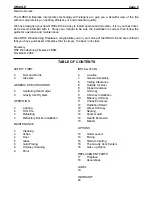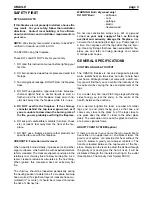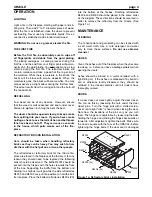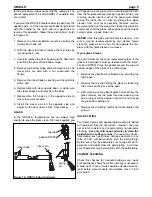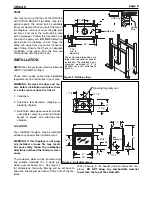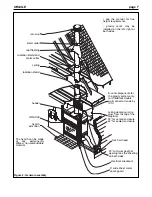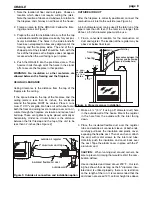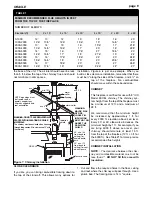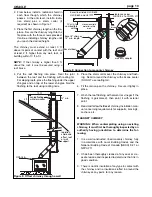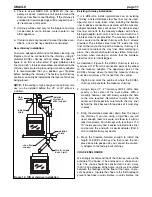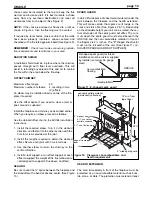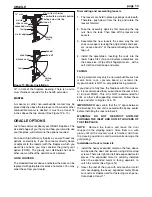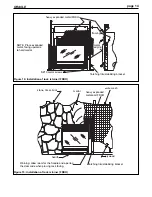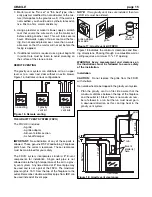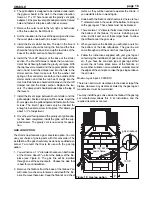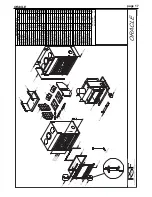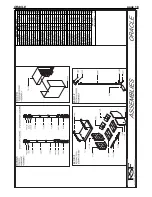
SAFETY FIRST
DO'S AND DON'TS
If this fireplace is not properly installed, a house fire
may result. For your safety, follow the installation
directions. Contact local building or fire officials
about restrictions and installation requirements in
your area.
NOTE:
We strongly recommend installers to be WETT
certified in Canada, and NFI in USA.
To ANYONE using this fireplace:
These DO's and DO NOT's are for your safety.
1. DO read this instruction manual before lighting your
first fire.
2. DO burn seasoned wood fuel or processed solid fuel
firelogs.
3. To avoid glass breakage, DO NOT slam the fireplace
door.
4. DO NOT use gasoline, type lantern fuel, kerosene,
charcoal lighter fluid or similar liquids to start or
freshen up a fire in this fireplace. Keep all such liq-
uids well away from the fireplace while it is in use.
5. DO NOT overfire the fireplace. If the chimney
connetor behind the top louver glows red, or if
you are unable to slow down the burning rate of
the fire, you are probably overfiring the fireplace.
6. DO keep all combustible materials (furniture, shoes
etc.) at least 4 feet away from the front of the fire-
place.
7. DO NOT use a fireplace insert or other products not
specified for use with this fireplace.
CREOSOTE: Formation and removal
When wood is burned slowly, it produces tar and other
organic vapours, which combine with expelled moisture
to form creosote. The creosote vapours condense in the
relatively cool chimney flue of a slow burning fire. As a
result, creosote residue accumulates in the flue lining.
When ignited, this creosote makes an extremely hot
fire.
The chimney should be inspected periodically during
the heating season to determine if a creosote build-up
has occurred. If a significant layer of creosote has accu-
mulated (¼" or more), it should be removed to reduce
the risk of chimney fire.
WARNING: Burn dry wood only !
DO NOT Burn:
- driftwood
- coal
- garbage
- plastic
- treated wood
Do not use construction scraps (e.g., 2x4 or plywood
scraps)
as your only supply of fuel, as this may
overheat and seriously damage the fireplace.
Use
no more than 3 densified fuel logs (e.g., Presto logs) at
a time. Do not poke or stir the logs while they are burn-
ing. Use only firelogs that have been evaluated for fire-
place use and refer to firelog warnings and caution
markings prior to use.
GENERAL SPECIFICATIONS
CONTROLLING HEAT OUTPUT
The ORACLE fireplace is not only designed to provide
warm radiant heat on two sides, but also to help heat
your home. Although it does not come with a draft con-
trol you will find that you can control the intensity of the
fire quite well by varying the size and placement of the
logs.
For a cooler, lazy fire: load 2 to 3 large logs with the log
sides facing you (not the ends), in the centre of the
hearth, between the andirons.
For a warmer, brighter fire: load a number of smaller
logs end to end (ends facing you) so that one end
comes very close to the glass (½ of the logs close to
one glass door, the other ½ closer to the other glass
door). The combustion air is near the glass and will cre-
ate a more vigorous flame.
GRAVITY VENT SYSTEM (option)
If there are areas in your home that you would like to
heat either in an upper level or an adjacent room, the
gravity vent system can provide this heat without the
use of a blower. A gravity vent damper controls it. The
handle is located between the top louvers of the fire-
place. Simply turn the lever to adjust the air flow through
the gravity vent ducting. As the hot air rises, it will be
distributed through the insulated ducting to the outlet
(See Options: The Gravity Vent System FDVO).
ORACLE
page 3


